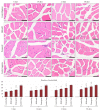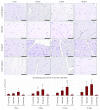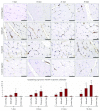Treatment with Sildenafil and Donepezil Improves Angiogenesis in Experimentally Induced Critical Limb Ischemia
- PMID: 28243607
- PMCID: PMC5294352
- DOI: 10.1155/2017/9532381
Treatment with Sildenafil and Donepezil Improves Angiogenesis in Experimentally Induced Critical Limb Ischemia
Abstract
Objectives. In this study, we aimed to demonstrate the role of sildenafil (an antagonist of phosphodiesterase type 5 (PDE-5)) and donepezil (a specific and reversible inhibitor of acetylcholinesterase (Ach)) in increasing ischemia-induced angiogenesis. Method. Critical limb ischemia was induced by ligation of the common femoral artery followed by ligation of the common iliac artery. The operated animals were divided into 3 groups: receiving sildenafil, receiving donepezil, and surgery alone; the contralateral lower limb was used as a negative control. The results were controlled based on clinical score and Doppler ultrasound. Gastrocnemius muscle samples were taken from all animals, both from the ischemic and nonischemic limb and were used for histopathological and immunohistochemical examination for the evaluation of the number of nuclei/field, endothelial cells (CD31), dividing cells (Ki-67), and vascular endothelial growth factor (VEGFR-3). Results. An increasing tendency of the number of nuclei/field with time was observed both in the case of sildenafil and donepezil treatment. The formation of new capillaries (the angiogenesis process) was more strongly influenced by donepezil treatment compared to sildenafil or no treatment. This treatment significantly influenced the capillary/fiber ratio, which was increased compared to untreated ligated animals. Sildenafil treatment led to a gradual increase in the number of dividing cells, which was significantly compared to the negative control group and compared to the ligation control group. The same effect (increase in the number of Ki-67 positive cells) was more obvious in the case of donepezil treatment. Conclusion. Donepezil treatment has a better effect in ligation-induced ischemia compared to sildenafil, promoting angiogenesis in the first place, and also arteriogenesis.
Conflict of interest statement
The authors declare that there is no conflict of interests regarding the publication of this paper.
Figures






Similar articles
-
Acetylcholinesterase inhibitors attenuate angiogenesis.Clin Sci (Lond). 2012 Aug 1;123(4):241-9. doi: 10.1042/CS20110633. Clin Sci (Lond). 2012. PMID: 22369073 Free PMC article.
-
Donepezil, an acetylcholinesterase inhibitor against Alzheimer's dementia, promotes angiogenesis in an ischemic hindlimb model.J Mol Cell Cardiol. 2010 Apr;48(4):680-93. doi: 10.1016/j.yjmcc.2009.11.010. Epub 2009 Dec 3. J Mol Cell Cardiol. 2010. PMID: 19962381
-
Beneficial Effects of Sildenafil on Tissue Perfusion and Inflammation in a Murine Model of Limb Ischemia and Atherosclerosis.Curr Vasc Pharmacol. 2017;15(3):282-287. doi: 10.2174/1570161115666170126123258. Curr Vasc Pharmacol. 2017. PMID: 28128066
-
Sildenafil increases endothelial progenitor cell function and improves ischemia-induced neovascularization in hypercholesterolemic apolipoprotein E-deficient mice.Hypertension. 2009 Nov;54(5):1043-9. doi: 10.1161/HYPERTENSIONAHA.109.139451. Epub 2009 Sep 21. Hypertension. 2009. PMID: 19770400
-
Influence of sildenafil and donepezil administration on the serum redox balance in experimentally induced lower limb critical ischemia.Clujul Med. 2013;86(3):250-8. Epub 2013 Aug 5. Clujul Med. 2013. PMID: 26527957 Free PMC article. Review.
Cited by
-
Thymosin‑β 4 induces angiogenesis in critical limb ischemia mice via regulating Notch/NF‑κB pathway.Int J Mol Med. 2020 Oct;46(4):1347-1358. doi: 10.3892/ijmm.2020.4701. Epub 2020 Aug 11. Int J Mol Med. 2020. PMID: 32945357 Free PMC article.
-
Efficacy of topical sildenafil formulations in enhancing wound healing outcomes: a narrative review.Arch Dermatol Res. 2025 Mar 28;317(1):642. doi: 10.1007/s00403-025-04152-8. Arch Dermatol Res. 2025. PMID: 40148506 Review.
-
Sildenafil-Induced Revascularization of Rat Hindlimb Involves Arteriogenesis through PI3K/AKT and eNOS Activation.Int J Mol Sci. 2022 May 16;23(10):5542. doi: 10.3390/ijms23105542. Int J Mol Sci. 2022. PMID: 35628350 Free PMC article.
-
Effect of the Phosphodiesterase 5 Inhibitor Sildenafil on Ischemia-Reperfusion-Induced Muscle Mitochondrial Dysfunction and Oxidative Stress.Antioxidants (Basel). 2019 Apr 7;8(4):93. doi: 10.3390/antiox8040093. Antioxidants (Basel). 2019. PMID: 30959961 Free PMC article.
References
-
- Yu J., DeMuinck E. D., Zhuang Z., et al. Endothelial nitric oxide synthase is critical for ischemic remodeling, mural cell recruitment, and blood flow reserve. Proceedings of the National Academy of Sciences of the United States of America. 2005;102(31):10999–11004. doi: 10.1073/pnas.0501444102. - DOI - PMC - PubMed
MeSH terms
Substances
LinkOut - more resources
Full Text Sources
Other Literature Sources
Miscellaneous

